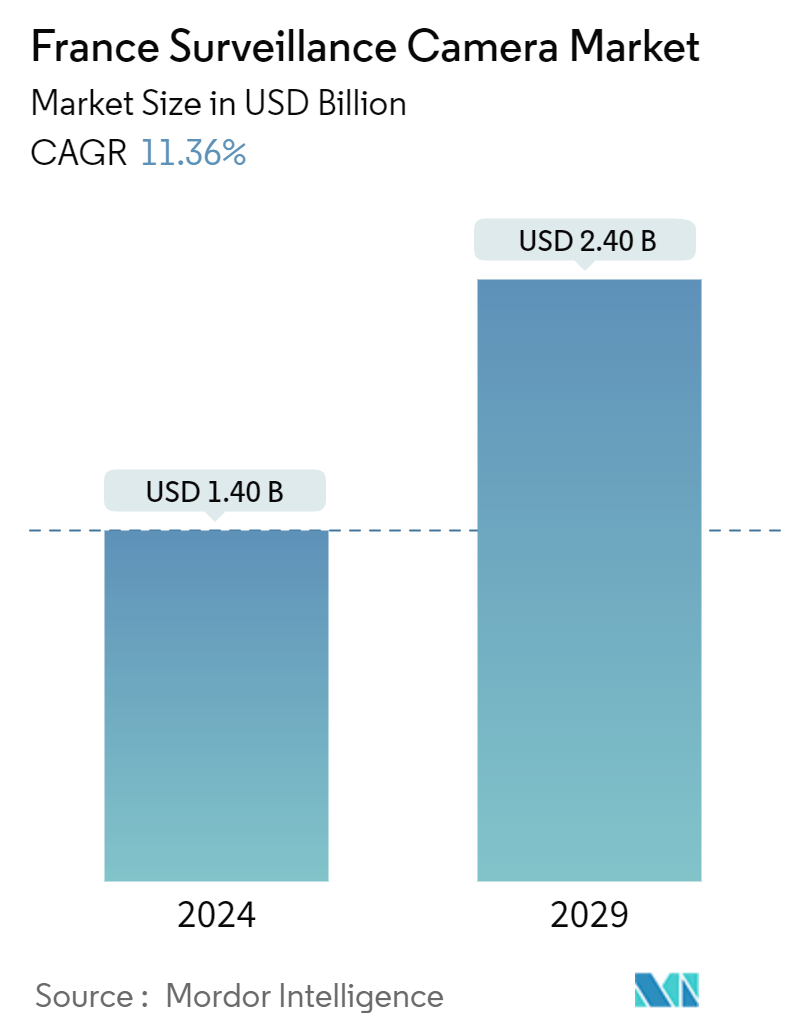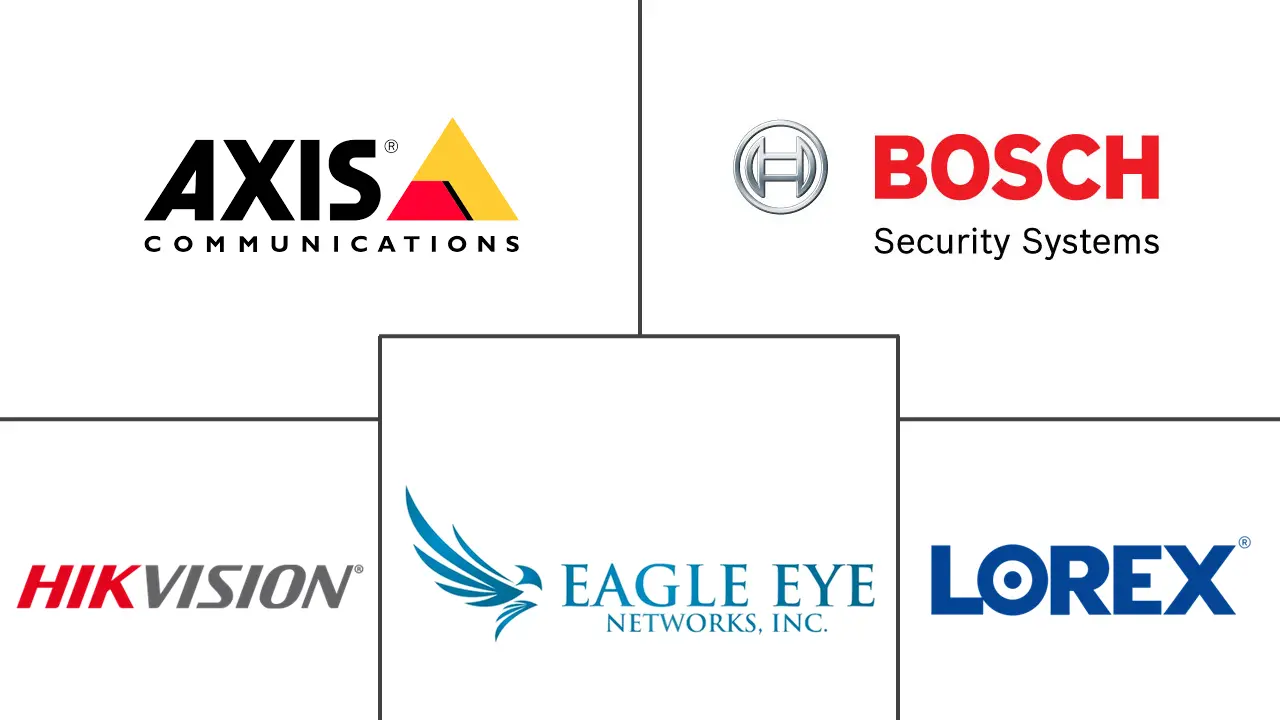Market Size of France Surveillance Camera Industry

| Study Period | 2019 - 2029 |
| Base Year For Estimation | 2023 |
| Market Size (2024) | USD 1.40 Billion |
| Market Size (2029) | USD 2.40 Billion |
| CAGR (2024 - 2029) | 11.36 % |
| Market Concentration | Low |
Major Players
*Disclaimer: Major Players sorted in no particular order |
France Surveillance Camera Market Analysis
The France Surveillance Camera Market size is estimated at USD 1.40 billion in 2024, and is expected to reach USD 2.40 billion by 2029, growing at a CAGR of 11.36% during the forecast period (2024-2029).
- The French surveillance camera market swiftly embraces cutting-edge tech, from high-definition cameras to cloud storage and advanced video analytics. These systems now excel in facial recognition and behavior analysis tasks by incorporating AI and machine learning. Manufacturers are innovating, adding features like thermal imaging and panoramic views to cater to the market's changing demands.
- France has faced a series of high-profile terrorist attacks, amplifying public concerns about security. For instance, in May 2024, a gang of armed individuals recently carried out a heist at a high-end Parisian boutique owned by the renowned 'Jeweler to the Stars,' making off with millions in valuables. This has underscored the necessity for bolstered surveillance capabilities. In response, the government has significantly ramped up investments in surveillance camera networks. These networks are primarily concentrated in major urban centers and critical infrastructure to bolster incident detection, response times, and overall prevention efforts. The strategic deployment of surveillance cameras is pivotal in the nation's fight against terrorism, organized crime, and broader public safety challenges.
- Paris, Lyon, and Marseille, among other major French cities, lead the way in smart city initiatives, prominently utilizing surveillance camera systems. These cameras are pivotal in traffic control, crowd oversight, and enhancing public services, collectively elevating the efficiency and residents' quality of life in these smart urban landscapes. Bolstering this, the French government has not only allocated funding but also crafted supportive policies to propel the uptake of smart city technologies, particularly surveillance networks.
- With the rising interconnectivity and network integration of surveillance camera systems, they face a growing susceptibility to cyber threats like hacking, data breaches, and malware. Implementing stringent cybersecurity measures to counter these risks and instill confidence in the technology is imperative. This includes adopting secure network protocols, encryption, and access controls. Tackling these challenges demands continual investment, regular software updates, and the cultivation of specialized expertise among security professionals.
- Under the GDPR, France has enacted stringent data privacy laws that significantly shape the implementation and utilization of surveillance camera systems. Regulatory bodies have set clear directives on the placement of these cameras, data management practices, and necessary privacy safeguards. These measures ensure compliance and address public concerns. Additionally, the French government is bolstering these efforts by offering tax breaks and financial incentives to promote the adoption of security technologies, notably surveillance camera systems.
- The Russia-Ukraine conflict has severely disrupted operations for companies, both foreign-owned and local, in the region. This conflict has exacerbated supply chain inefficiencies, leading to delays, labor shortages, transportation bottlenecks, and extended customs procedures. Ultimately, these inefficiencies translate into higher costs for end consumers.
France Surveillance Camera Industry Segmentation
Surveillance cameras in public spaces are deployed to monitor activities, gather information, and manage or direct operations remotely. The revenue from sales of surveillance camera products across diverse end-user industries gauges the market size. The study also examines growth patterns and how macroeconomic factors shape the market.
France's surveillance camera market is segmented by type (analog-based, IP-based) and by end-user industry (government, banking, healthcare, transportation and logistics, industrial, and other end-user industries [education institutions, retail, and enterprises]). The report offers market forecasts and size in value (USD) for all the above segments.
| By Type | |
| Analog Based | |
| IP Based |
| By End-user Industry | |
| Government | |
| Banking | |
| Healthcare | |
| Transportation and Logistics | |
| Industrial | |
| Other End-user Industries (Education Institutions, Retail, and Enterprises) |
France Surveillance Camera Market Size Summary
The surveillance camera market in France is experiencing significant growth, driven by the rapid adoption of advanced technologies such as high-definition cameras, cloud storage, and AI-powered video analytics. These innovations are enhancing capabilities in facial recognition and behavior analysis, meeting the evolving demands for security solutions. The market's expansion is further fueled by increased government investments in surveillance networks, particularly in urban centers and critical infrastructure, to address public safety concerns stemming from terrorism and organized crime. The integration of surveillance systems into smart city initiatives in cities like Paris, Lyon, and Marseille is also contributing to the market's growth, as these systems play a crucial role in traffic management, crowd control, and improving public services.
The market is characterized by a fragmented landscape with several global players investing in research and strategic partnerships to maintain competitiveness. Companies are focusing on innovation, introducing features like thermal imaging, panoramic views, and advanced AI capabilities to enhance surveillance effectiveness. The market's growth is supported by regulatory frameworks such as GDPR, which, while imposing strict data privacy laws, also encourages the adoption of surveillance technologies through financial incentives. However, challenges such as cybersecurity threats and supply chain disruptions due to geopolitical tensions, like the Russia-Ukraine conflict, pose risks to market stability. Despite these challenges, the demand for surveillance cameras in France continues to rise, driven by the need for enhanced security in various sectors, including transportation, logistics, and retail.
France Surveillance Camera Market Size - Table of Contents
-
1. MARKET INSIGHTS
-
1.1 Market Overview
-
1.2 Industry Attractiveness - Porter's Five Forces Analysis
-
1.2.1 Threat of New Entrants
-
1.2.2 Bargaining Power of Buyers
-
1.2.3 Bargaining Power of Suppliers
-
1.2.4 Threat of Substitute Products
-
1.2.5 Intensity of Competitive Rivalry
-
-
1.3 Industry Value Chain Analysis
-
1.4 An Assessment of Macroeconomic Trends on the Market
-
-
2. MARKET SEGMENTATION
-
2.1 By Type
-
2.1.1 Analog Based
-
2.1.2 IP Based
-
-
2.2 By End-user Industry
-
2.2.1 Government
-
2.2.2 Banking
-
2.2.3 Healthcare
-
2.2.4 Transportation and Logistics
-
2.2.5 Industrial
-
2.2.6 Other End-user Industries (Education Institutions, Retail, and Enterprises)
-
-
France Surveillance Camera Market Size FAQs
How big is the France Surveillance Camera Market?
The France Surveillance Camera Market size is expected to reach USD 1.40 billion in 2024 and grow at a CAGR of 11.36% to reach USD 2.40 billion by 2029.
What is the current France Surveillance Camera Market size?
In 2024, the France Surveillance Camera Market size is expected to reach USD 1.40 billion.

